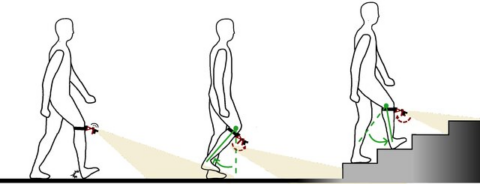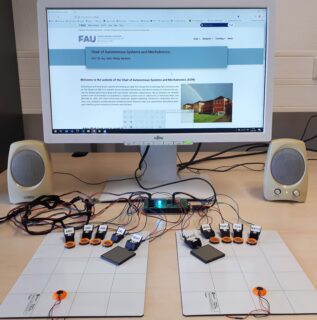Index
Studentische Arbeiten und Projekte
Anfragen zu Master- und Bachelorarbeiten und Forschungspraktika sind jederzeit willkommen. Bitte schauen Sie sich die Forschungsinteressen des wissenschaftlichen Personals an und kontaktieren Sie die wissenschaftlichen Beschäftigten, deren Inhalte zu Ihren Interessen passen.
Offene Arbeiten:
Design and Evaluation of a Wearable Feedback Device for Posture Correction in Parkinson’s Disease Patients
Design and Development of a Wearable Robotic Vision System with Stabilized Imaging for Terrain Classification in Lower Limb Prostheses
Schätzung der Muskelkräfte bei hochintensiven Richtungswechselbewegungen mit Schwerpunkt auf der Prävention von Knieverletzungen.
Entwurf und Integration haptischer Schnittstellen: Menschliche Wahrnehmung und deren entwicklungsmethodische Berücksichtigung
Monocular Depth Estimation for Prosthesis Control
Geplante Präsentationen von studentischen Arbeiten:
Keine bevorstehenden Veranstaltungen.
Wintersemester
| Lecturers: | Philipp Beckerle, Mehmet Ege Cansev | 5 ECTS |
| Semester: WS | Duration: 1 Semester | Frequency: annual (WS) |
| Attendance: 60 hours | Self-Study: 90 hours | Language: English |
Courses:
Robot Mechanisms and User Interfaces (WS, Lecture, 2 SWS, Philipp Beckerle)
Exercises for Robot Mechanisms and User Interfaces (WS, Exrcises, 2 SWS, Mehmet Ege Cansev)
Content:
- Mechanical components
- Robot mechanisms
- Kinematic parameters and calculations
- Evaluation metrics and design methods
- Redundant mechanisms and actuation
- Human-robot interfaces
- Intend detection (sensing) and haptic stimulation (actuators)
- Interface system design and evaluation
The laboratory exercise will be a mini design project in which student groups create their own low-budget haptic human-machine interfaces.
Learning objectives and competencies:
On successful completion of this module, students will be able to:
- Understand robot mechanisms and apply kinematic calculations for their design and control.
- Exploit redundancy in kinematic chains and actuation systems.
- Know components of human-machine interfaces and be able to design such systematically.
- Know approaches to model human characteristics and behavior for human-machine interface design.
| Dozent: | Philipp Beckerle, Matthias Voß | 5 ECTS |
| Semester: WS | Duration: 1 Semester | Wiederholung: jährlich (WS) |
| Präsenzzeit :
60 hours |
Selbststudium: 90 hours | Language: Deutsch |
Inhalt:
- Einführung in die Sensorik
- Wandlerprinzipien
- Sensor-Parameter
- Messung mechanischer Größen
- Signalverarbeitung
Lernziele und Kompetenzen:
Die Studierenden sollen die grundlegenden Verfahren bei der Messung nicht-elektrischer Größen mit Hilfe elektrischer Sensoren kennenlernen und verstehen, wie diese bei Aufgaben aus dem Bereich der modernen industriellen Prozessmesstechnik angewandt werden. Dazu werden die wichtigsten in der Sensorik verwendeten Prinzipien zur Wandlung physikalischer Größen in elektrische Signale behandelt. Hierbei wird auf die anwendungstechnischen Gesichtspunkte von Sensoren zur Messung elektromechanischer Größen in mechatronischen Komponenten und Systemen eingegangen. Dies beinhaltet auch die Betrachtung von elektrischen Schaltungen und Algorithmen zur Auswertung einzelner oder mehrerer Wandler.
| Dozent: | Philipp Beckerle, Daniel Andreas | 5 ECTS |
| Semester: WS | Duration: 1 Semester | Wiederholung: jährlich (WS) |
| Präsenzzeit :
60 hours |
Selbststudium: 90 hours | Language: Deutsch |
Inhalt:
- Umfang und Bedeutung der elektrischen Messtechnik
- Die Grundlagen des Messens
- Fourier-Transformation
- Laplace-Transformation
- Netzwerkanalyse im Zeit- und Laplace-Bereich
- Übertragungsfunktion und Bode-Diagramm
- Nichtlineare Bauelemente, Schaltungen und Systeme
- Operationsverstärker
- Messverstärker
- Messfehler
- Messung von Gleichstrom und Gleichspannung
- Ausschlagbrücken
- Abgleichbrücken, Messung von elektrischen Impedanzen
Lernziele und Kompetenzen:
Die Studierenden
- ordnen die behandelten Verfahren gemäß ihrer Eignung für spezifische Probleme (Zeit-/Frequenzbereich, Linear/Nichtlinear) ein.
- wählen geeignete Verfahren zur Analyse elektrischer Netzwerke aus und wenden diese an.
- interpretieren die Ergebnisse und zeigen Zusammenhänge zwischen den Lösungsverfahren auf.
- kennen einfache Grundschaltungen mit Operationsverstärkern und sind in der Lage, diese zu analysieren.
- kennen die behandelten Messschaltungen und ihre Einsatzmöglichkeiten.
- analysieren Brückenschaltungen.
- wenden grundlegende Konzepte der Messfehlerrechnung auf Messschaltungen an.
- reflektieren selbstständig den eigenen Lernprozess und nutzen die Präsenzzeit zur Klärung der erkannten Defizite.
| Lecturers: | Philipp Beckerle | 2.5 ECTS |
| Semester: WS | Duration: 1 Semester | Frequency: annual(WS) |
| Attendance: 24 hours | Self-Study: 51 | Language: English |
Courses:
Autonomous Systems: From Research to Products (WS, Lecture, 2.5 SWS, Philipp Beckerle)
Content:
- Autonomous Systems
- Actuators
- Mechanics and Mechatronics
- Simulation
- Power Electronics
- Control
- Connectivity and Localization
- Sensors
- Internet of Things
- Regulatory Aspects
- Materials and Additive Manufacturing
The lecture will comprise of 2x 30 minutes impulse talks by Siemens/FAU experts followed by a 30 minutes discussion by everybody (language flexible for students)
Learning objectives and competencies:
On successful completion of this module, students will be able to:
- describe and discuss autonomous systems and their components.
- understand the challenges of the hardware and software design and their interactions.
- scale solutions by connectivity.
- understanding the obstacles for industrial realization from theoretical considerations and getting the product in to the market.
| Lecturers: | Philipp Beckerle, Adna Bliek | 2,5 ECTS |
| Semester: WS | Duration: 1 Semester | Frequency: annual (WS) |
| Attendance: 10 hours | Self-Study: 65 hours | Language: English |
Course:
Seminar Mensch-Roboter-Interaktion (WS, Seminar, 2 SWS, compulsory attendance, Philipp Beckerle, Adna Bliek)
Content:
In the seminar, students will analyze, present, and discuss recent research topics in human-robot-interaction. This will comprise aspects of cognitive and physical human-robot interaction and related topics of human and engineering sciences. Besides reflecting contemporary literature, the students are asked to conclude and suggest directions for future research.
Learning objectives and competencies:
On successful completion of this module, students will be able to comprehend and convey recent research challenges in the area of human-robot interaction. Moreover, they are prepared to infer future research lines from recent developments.
| Lecturers: | Philipp Beckerle, Rodrigo J. Velasco Guillen | 2,5 ECTS |
| Semester: WS | Duration: 1 Semester | Frequency: semi-annual (WS + SS) |
| Attendace: 10 hours | Self-Study: 65 hours. | Language: English |
Course:
Seminar Autonomous Systems and Mechatronics (WS, Seminar, 2 SWS, compulsory attendance, Philipp Beckerle, Rodrigo J. Velasco Guillen)
Content:
In the seminar, students will analyze, present. and discuss recent research topics in autonomous systems and mechatronics. This will comprise mechatronic component, system, and control design as well as advanced methods aiming at autonomous operation. Besides reflecting contemporary literature, the students are asked to conclude and suggest directions for future research.
Learning objectives and competencies:
On successful completion of this module, students will be able to comprehend and convey recent research challenges in the area of autonomous system and mechatronics. Moreover, they are prepared to infer future research lines from recent developments.
| Lecturers: | Philipp Beckerle, Martin Rohrmüller | 2,5 ECTS |
| Semester: WS | Duration: 1 Semester | Frequency: annual (SS) |
| Attendance: 30 hours | Self-Study: 45 hours | Language: English |
Courses:
Human-Robot Interaction Laboratory (WS, Praktikum, Philipp Beckerle).
Content:
Six experiments are completed in the HRI (Human-Robot Interaction) practical course. After an introduction to ROS and Python, three experiments are carried out with a Franka-Emika lightweight robot and two experiments with a humanoid NAO robot. The structure of each experiment is composed of a preparation phase, an execution phase, and a reflection phase, in which the participants work in groups on tasks to create a complex application on each of the platforms.
- Introduction to the Robot Operating System (ROS)
- Introduction to Python
- Teleoperation of the lightweight robot
- Collaboration with the lightweight robot
- Collision detection and reconfiguration with the lightweight robot
- Object recognition with the humanoid robot as platform
- Object recognition with neural networks
Learning objectives and competencies:
Upon completion of the lab course, students will be able to understand the basic concepts of ROS and design applications of a lightweight robot in terms of human-machine interaction. They will learn how humanoid robots work and assess their current state of the art.






